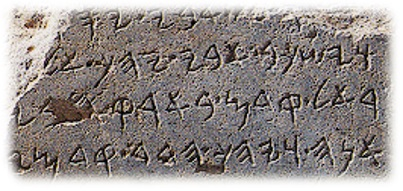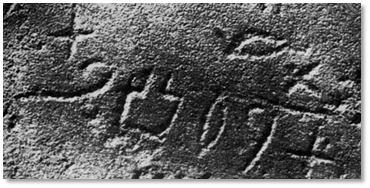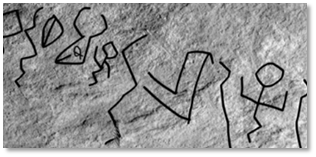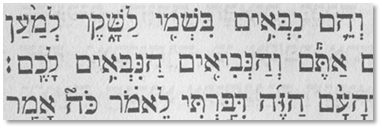 By Jeff A. Benner Old Hebrew and the Samaritan AlphabetFigure 1 – The Modern Hebrew Alphabet The mention of the Hebrew alphabet brings to mind the Hebrew letters that are familiar to many today that are used in Torah scrolls, Hebrew Bibles and even in Modern Hebrew Books and Newspapers. However, history suggests that these Hebrew letters are not the same Hebrew letters used in antiquity.
 Figure 2 – Judean Half Shekel (Image courtesy of Classical Numismatic Group, Inc.) Hartwell continues: "But the most decisive confirmation of this point is to be found in ancient Hebrew coins, which were struck before the [Babylonian] captivity, and even engraven on all of them are manifestly the same with the modern Samaritan." [1]
 Figure 3 – The Samaritan Torah Scroll The Torah Scroll of the Samaritans use an alphabet that is very different from the one used on Jewish Torah Scrolls. According to the Samaritans themselves and Hebrew scholars, this alphabet is the original "Old Hebrew" alphabet.
 Figure 4 – A portion of the Aleppo Codex The Hebrew Torah (Pentateuch) was originally written with an alphabet similar to that of the Samaritans, but after the Exile in Babylon it was transcribed with the Chaldean square alphabet, which was still used 1,000 years ago for the Aleppo Codex and is still used today in modern Hebrew. Old Hebrew and the Phoenician Alphabet Figure 5 – A portion of a text from a Phoenician inscription While Prideaux noted that the Old Hebrew alphabet was the same as the Samaritan alphabet, he also pointed out that it is identical to the Phoenician alphabet. When we compare the letters of these three alphabets, we can see this similarity.  Figure 6 – The letter "beyt" in Old Hebrew, Samaritan and Phoenician This is the letter beyt in the Old Hebrew.. the Samaritan… and the Phoenician. Note the close similarity of each. Also note the similarities of the letter hey in each of these alphabets.
 Figure 7 – Sarcophagus found in Sidon with Phoenician inscription The first major discovery connecting the Phoenician alphabet and language with Hebrew occurred on January 19th, 1855, when Turkish laborers accidently uncovered an ancient sarcophagus in Sidon, a Phoenician city. On this sarcophagus was a lengthy inscription written in the Phoenician alphabet and language, which was found to be identical to Hebrew with only a few exceptions. Old Hebrew Discoveries Figure 8 – Meshe Stele inscription The Meshe Stele, also called the Moabite Stone, was discovered in 1868 in the Biblical city of Dibon, the capital of the Moabites. The inscription was written with the same letters as the Phoenician, old Hebrew and Samaritan and it was discovered that Moabite language was also the same as Hebrew with some minor variations.  Figure 9 – The Siloam Inscription The Siloam Inscription, discovered in 1880, is written on the wall of Hezekiah's tunnel, which connects Gihon spring to the Pool of Siloam in East Jerusalem. This Hebrew inscription was written in the same style as the Phoenician and Moabite inscriptions.  Figure 10 – The Gezer Calendar During the excavation of the city of Gezer, 30 miles from Jerusalem, a limestone tablet was discovered in 1908 with a Hebrew inscription written in the old Hebrew alphabet.  Figure 11 – A Lachish Ostracon In 1935 eighteen ostraca (broken pottery fragments) were discovered in the ancient city of Lachish with Hebrew writing in the old Hebrew alphabet.  Figure 12 – An Ammonite inscription In 1966 an inscription was discovered in Amman Jordan with an Ammonite inscription whose alphabet and language was also similar to Phoenician and Hebrew.  Figure 13 – The Tel Dan Inscription The Tel-Dan Stele, discovered in northern Israel in 1993, is an Aramaic inscription using the same old Hebrew script. This inscription also revealed another amazing fact.  Figure 14 – The phrases "king of Israel" (top) and "house of David" (bottom). The inscription includes the phrase מלך ישראל (melek yisrael) meaning "king of Israel" and the line below reads בית דוד (beyt david) meaning "house of david." These phrases are extra-Biblical evidence confirming the existence of not only the nation of Israel, but also king David. Old Hebrew to Greek and Aramaic Figure 15 – The Greek Alphabet on ancient inscription The old-Hebrew alphabet, also called paleo-Hebrew, was adopted by the Greeks around the 12th century BC.  Figure 16 – The first five letters of the Old Hebrew alphabet The first five letters of the Hebrew alphabet are aleph, beyt, gimel, dalet and hey. These same letters, adopted by the Greeks, became the alpha, beta, gamma, delta and E-psilon (meaning simple E).  Figure 17 – The first five letters of the Old Greek alphabet While Hebrew is usually written from right to left, Greek was written left to right and the orientation of the letters were reversed.  Figure 18 – The Modern Greek alphabet Over the centuries, these ancient Greek letters evolved into their Modern Greek forms.  Figure 19 – The Modern Roman alphabet Our English alphabet is Roman, and because the Romans adopted the Greek alphabet, we are able to see our own modern English alphabet in these ancient Hebrew turned Greek letters, the A, B, C, D and E. The Aramaic AlphabetAs previously mentioned, the old Hebrew alphabet was used by all Semitic peoples including the Arameans (also called the Chaldeans), but evolved independently from the Hebrew.  Figure 20 – 5th Century B.C. Hebrew (Aramaic) alphabet By the 5th century B.C., the time of the Israelites captivity in Aramea (or Babylon), it no longer resembled the old Hebrew it came from and it is this Aramaic "square" script that Israel adopted during their captivity.  Figure 21 – The modern Hebrew (Aramaic) alphabet This old Aramaic alphabet, now being used by the Israelites, continued to evolve into the modern letters we are familiar with today. Alphabet OriginsBy the end of the 19th century, the translation of the Semitic alphabet was well established. The only mystery was the origin of this alphabet as mentioned in "A Compendius and Complete Hebrew and Chaldee Lexicon to the Old Testament" published in 1886.
The 1922 New Larned History for Ready Reference, Reading and Research, in its entry for the letter "A," also notes the suspected origins of the Hebrew alphabet. "A, the initial letter of the English and almost all other alphabets… The Phoenicians called the letter "aleph" seemingly because of the resemblance of the character to the head of an ox. Although nothing is known with any degree of certainty concerning the ultimate origin of this letter." [9]
The Proto-Semitic AlphabetIn 1905, a new discovery in the Sinai Peninsula changed the world's perception of the origins of this Semitic alphabet.
 Figure 22 – Ancient inscription from Serabit El-Khadim Dr. Alan H. Gardiner, Another renowned Egyptologist, studied these inscriptions in detail. He discovered that these Sinaitic inscriptions consisted of a total of thirty-two symbols. Because of the limited number of symbols Dr. Gardiner determined that this was an alphabet. [10]
 Figure 23 – Ancient Sinaitic letters Dr. Gardiner found that the letters in these ancient Sinaitic inscriptions were pictures of the very names of the Hebrew letters. The image of an ox head (left) was the letter aleph, the image of the hand (center) was the letter yad and the image of an eye (right) was the letter ayin.
 Figure 24 – The L'Balt inscription Once it was determined that the new script was Semitic, Dr. Gardiner, in 1916, was able to translate a portion of one inscription. This inscription includes the letters lamed, beyt, ayin, lamed and tav, which form the Semitic word לבעלת (l'balt), meaning "to the lady." [11]  Figure 25 – The Wadi El-Hhol inscription (Photograph by John Melzian of the West Semitic Research Project) In 1999, John and Deborah Darnell were surveying ancient travel routes in the deserts of southern Egypt when they came upon another set of inscriptions very similar to the Sinaitic inscriptions found by Petrie. Dating the Semitic AlphabetThe inscriptions discovered in the past century and a half, have been accurately dated through the advances of archeology. The original Semitic alphabet with its pictographic letters can be divided into three periods; Early, Middle and Late.
 Figure 26 – Text from a Modern Hebrew Bible The late Semitic script continued to be used for the works of the Talmud, the Masoretic Hebrew Bible as well the printed Hebrew Bibles of today. ^ 1. Thomas Hartwell, An introduction to the Critical Study and Knowledge of the Holy Scriptures, Pub. 1854, Page 190 ^ 2. Henry Dodwell, A Discourse Concerning Sanchoniathon's Phoenician History, Pub. 1691, Page 118 ^ 3. Humphrey Prideaux, The Old and New Testament connected in the history of the Jews and Neighbouring Nations, Pub. 1799, Page 431 ^ 4. Encyclopedia Americana, Hebrew Language and Literature, Pub. 1831, Page 212 ^ 5. Encyclopedia Americana, Hebrew Language and Literature, Pub. 1831, Page 212 ^ 6. The Foreign quarterly review, Phoenician Inscriptions, Pub. 1838, Page 446 ^ 7. The Foreign quarterly review, Phoenician Inscriptions, Pub. 1838, Page 445 ^ 8. Benjamin Davies, Edward Cushing Mitchel, A Compendius and Complete Hebrew and Chaldee Lexicon to the Old Testament, Pub 1886, Page 1 ^ 9. The New Larned History for Ready Reference, Reading and Research, Pub. 1922, Page 1 ^ 10. The New Larned History for Ready Reference, Reading and Research: The Actual .. - Page 225 ^ 11. The American Journal of Semitic Languages and Literatures By University of Chicago. Dept. of Semitic Languages and Literatures (1919) Page 35 - the PSI proved the names of the Hebrew letters - aleph (ox) beyt (house) etc. |



